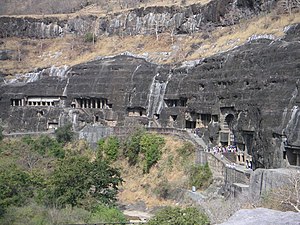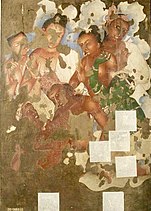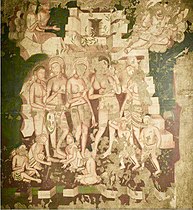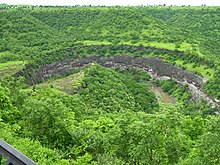ajanta caves
Ajanta Caves : They were abandoned and forgotten for centuries, until a British officer rediscovered them in 1819 while hunting a tiger Ajanta Caves - Wikipedia
| UNESCO World Heritage Site | |
|---|---|
 The Ajanta Caves | |
| Location | Ajanta, district, Maharashtra, India |
| Criteria | Cultural: i, ii, iii, vi |
| Reference | 242 |
| Inscription | 1983 (7th Session) |
| Area | 8,242 ha |
| Buffer zone | 78,676 ha |
| Coordinates | 20°33′12″N 75°42′01″E |
The caves consist of 36 identifiable foundations,[8] some of them discovered after the original numbering of the caves from 1 through 29. The later-identified caves have been suffixed with the letters of the alphabet, such as 15A, identified between originally numbered caves 15 and 16.[25] The cave numbering is a convention of convenience, and does not reflect the chronological order of their construction.
Natives, society and culture in the arts at Ajanta[edit]
The Ajanta cave arts are a window into the culture, society and religiosity of the native population of India between the 2nd century BCE and 5th century CE. Different scholars have variously interpreted them from the perspective of gender studies, history, sociology, and the anthropology of South Asia.[267][268] The dress, the jewelry, the gender relations, the social activities depicted showcase at least a lifestyle of the royalty and elite,[269] and in others definitely the costumes of the common man, monks and rishi depicted therein. They shine "light on life in India" around mid 1st millennium CE.[270][271]
The Ajanta artworks provide a contrast between the spiritual life of monks who had given up all materialistic possessions versus the sensual life of those it considered materialistic, luxurious, symbols of wealth, leisurely and high fashion. Many frescos show scenes from shops, festivals, jesters at processions, palaces and performance art
They are universally regarded as masterpieces of Buddhist religious art. The caves were built in two phases, the first starting around the second century BCE and the second occurring from 400 to 650 CE, according to older accounts, or in a brief period of 460–480 CE according to later scholarship.[6] The site is a protected monument in the care of the Archaeological Survey of India,[7] and since 1983, the Ajanta Caves have been a UNESCO World Heritage Site.
The Ajanta Caves constitute ancient monasteries (Chaityas) and worship-halls (Viharas) of different Buddhist traditions carved into a 75-metre (246 ft) wall of rock.[8][9] The caves also present paintings depicting the past lives [10] and rebirths of the Buddha, pictorial tales from Aryasura's Jatakamala, and rock-cut sculptures of Buddhist deities.[8][11][12] Textual records suggest that these caves served as a monsoon retreat for monks, as well as a resting site for merchants and pilgrims in ancient India.[8] While vivid colours and mural wall painting were abundant in Indian history as evidenced by historical records, Caves 16, 17, 1 and 2 of Ajanta form the largest corpus of surviving ancient Indian wall-painting.[13]
The Ajanta Caves are mentioned in the memoirs of several medieval-era Chinese Buddhist travellers.[14] They were covered by jungle until accidentally "discovered" and brought to Western attention in 1819 by a colonial British officer Captain John Smith on a tiger-hunting party.[15] The caves are in the rocky northern wall of the U-shaped gorge of the river Waghur,[16] in the Deccan plateau.[17][18] Within the gorge are a number of waterfalls, audible from outside the caves when the river is high.[19]
With the Ellora Caves, Ajanta is one of the major tourist attractions of Maharashtra. It is about 59 kilometres (37 miles) from the city of Jalgaon, Maharashtra, India, 104 kilometres (65 miles) from the city of Aurangabad, and 350 kilometres (220 miles) east-northeast of Mumbai.[8][20] Ajanta is 100 kilometres (62 miles) from the Ellora Caves, which contain Hindu, Jain and Buddhist caves, the last dating from a period similar to Ajanta. The Ajanta style is also found in the Ellora Caves and other sites such as the Elephanta Caves, Aurangabad Caves, Shivleni Caves and the cave temples of Karnataka
The earliest group consists of caves 9, 10, 12, 13 and 15A. The murals in these caves depict stories from the Jatakas.[26] Later caves reflect the artistic influence of the Gupta period,[26] but there are differing opinions on which century in which the early caves were built.[27][28] According to Walter Spink, they were made during the period 100 BCE to 100 CE, probably under the patronage of the Hindu Satavahana dynasty (230 BCE – c. 220 CE) who ruled the region.[29][30] Other datings prefer the period of the Maurya Empire (300 BCE to 100 BCE).[31] Of these, caves 9 and 10 are stupa containing worship halls of chaitya-griha form, and caves 12, 13, and 15A are vihāras (see the architecture section below for descriptions of these types).[25] The first Satavahana period caves lacked figurative sculpture, emphasizing the stupa instead.
According to Spink, once the Satavahana period caves were made, the site was not further developed for a considerable period until the mid-5th century.[32] However, the early caves were in use during this dormant period, and Buddhist pilgrims visited the site, according to the records left by Chinese pilgrim Faxian around 400 CE.[25]
who built Ajanta caves "very probably included foreigners".[298]
LINK
- Ajanta Caves Bibliography, Akira Shimada (2014), Oxford University Press
- The Early Development of the Cave 26-Complex at Ajanta
- The Greatest Ancient Picture Gallery. William Dalrymple, New York Review of Books (23 Oct 2014)
- Ajanta Caves in UNESCO List
- Google Streetview Tours of each Cave of Ajanta
- Inscriptions with Translations: Ajanta Caves, Richard Cohen





![Cave 2, ceiling: foreigners sharing a drink of wine[299]](https://upload.wikimedia.org/wikipedia/commons/thumb/4/41/Ajanta_Cave_2_Veranda_ceiling_foreigners.jpg/125px-Ajanta_Cave_2_Veranda_ceiling_foreigners.jpg)
![Cave 1, ceiling: another Persian-style foreign group, one of the four such groups (one now missing) at the center of each quadrant of the ceiling[287]](https://upload.wikimedia.org/wikipedia/commons/thumb/1/10/Ajanta_foreigner_2.jpg/125px-Ajanta_foreigner_2.jpg)
![A servant from Central Asia, Cave 17.[289]](https://upload.wikimedia.org/wikipedia/commons/thumb/b/ba/Ajanta_Cave_17_foreign_servant.jpg/83px-Ajanta_Cave_17_foreign_servant.jpg)
![Cave 17: foreigners attending the Buddha[300]](https://upload.wikimedia.org/wikipedia/commons/thumb/e/ec/Ajanta_Cave_17_Descent_from_Heaven_Left_Wall_foreigners_detail.jpg/87px-Ajanta_Cave_17_Descent_from_Heaven_Left_Wall_foreigners_detail.jpg)
Comments
Post a Comment